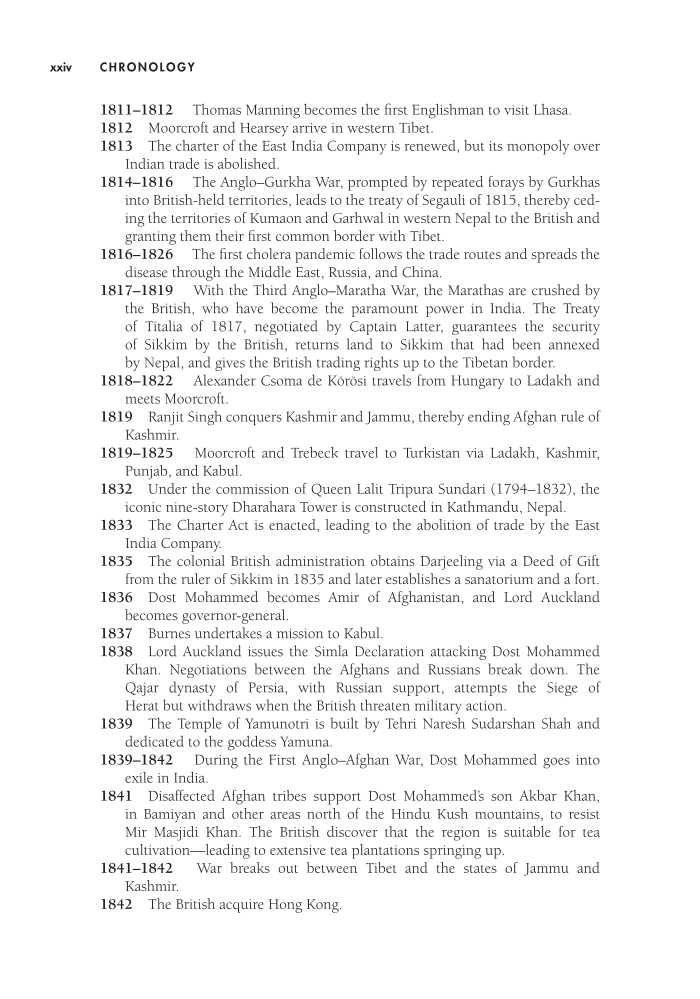xxiv Chronology 1811–1812 Thomas Manning becomes the first Englishman to visit Lhasa. 1812 Moorcroft and Hearsey arrive in western Tibet. 1813 The charter of the East India Company is renewed, but its monopoly over Indian trade is abolished. 1814–1816 The Anglo–Gurkha War, prompted by repeated forays by Gurkhas into British-held territories, leads to the treaty of Segauli of 1815, thereby ced- ing the territories of Kumaon and Garhwal in western Nepal to the British and granting them their first common border with Tibet. 1816–1826 The first cholera pandemic follows the trade routes and spreads the disease through the Middle East, Russia, and China. 1817–1819 With the Third Anglo–Maratha War, the Marathas are crushed by the British, who have become the paramount power in India. The Treaty of Titalia of 1817, negotiated by Captain Latter, guarantees the security of Sikkim by the British, returns land to Sikkim that had been annexed by Nepal, and gives the British trading rights up to the Tibetan border. 1818–1822 Alexander Csoma de Körösi travels from Hungary to Ladakh and meets Moorcroft. 1819 Ranjit Singh conquers Kashmir and Jammu, thereby ending Afghan rule of Kashmir. 1819–1825 Moorcroft and Trebeck travel to Turkistan via Ladakh, Kashmir, Punjab, and Kabul. 1832 Under the commission of Queen Lalit Tripura Sundari (1794–1832), the iconic nine-story Dharahara Tower is constructed in Kathmandu, Nepal. 1833 The Charter Act is enacted, leading to the abolition of trade by the East India Company. 1835 The colonial British administration obtains Darjeeling via a Deed of Gift from the ruler of Sikkim in 1835 and later establishes a sanatorium and a fort. 1836 Dost Mohammed becomes Amir of Afghanistan, and Lord Auckland becomes governor-general. 1837 Burnes undertakes a mission to Kabul. 1838 Lord Auckland issues the Simla Declaration attacking Dost Mohammed Khan. Negotiations between the Afghans and Russians break down. The Qajar dynasty of Persia, with Russian support, attempts the Siege of Herat but withdraws when the British threaten military action. 1839 The Temple of Yamunotri is built by Tehri Naresh Sudarshan Shah and dedicated to the goddess Yamuna. 1839–1842 During the First Anglo–Afghan War, Dost Mohammed goes into exile in India. 1841 Disaffected Afghan tribes support Dost Mohammed’s son Akbar Khan, in Bamiyan and other areas north of the Hindu Kush mountains, to resist Mir Masjidi Khan. The British discover that the region is suitable for tea cultivation—leading to extensive tea plantations springing up. 1841–1842 War breaks out between Tibet and the states of Jammu and Kashmir. 1842 The British acquire Hong Kong.
Document Details My Account Print multiple pages
Print
You have printed 0 times in the last 24 hours.
Your print count will reset on at .
You may print 0 more time(s) before then.
You may print a maximum of 0 pages at a time.







































































































































































































































































































































































